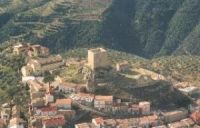
dal 1996 in continua innovazione tecnologica!
Sfrutta tecnologie avanzate per avere un sito web ottimizzato al 100%

THE VILLAGES foothills
In the green heart of Calabria, at the foot of the Sila alternate rural landscapes in the woods where there are areas rich in history that give glimpses of rare beauty.
Belcastro - Andals - Sersale - Zagarise
Our journey begins in Belcastro, a fief of the Counts of Aquino immediate family of the famous philosopher Thomas. Their castle, the thirteenth century, of which there are walls, towers and a cappalla (which seems to be born saint) overlooking the village. Next to the castle is the former St. Michael's Cathedral which has a sixteenth-century fašade decorated with three stone doorways carved by master roglianesi.
Other monuments of note:
Church of the PietÓ: holds a Greek Icon on Wood, Veneto-Cretan School representative Madonna and Child, by Byzantine (1000-1200), three baroque sculptures depicting the Annunciation with the Archangel Gabriel, s. Anna and Almighty God, it is remarkable the front door with long lancet arches tuff section of sec. XV. The church, which already existed in 1603, it was rebuilt and enlarged by an agreement between the canonical owner Don Scipione Vivacqua and brothers of the Congregation of the PietÓ, as is clear from the documents preserved in the archives of the Archbishop of Santa Severina.
St. Rocco Church : Built in 1645, the Duke of Belcastro Francis Sersale as the family chapel: the portal, rectangular stone columns, is the work of local sculptors of the century. XVII. Has undergone many changes, one of the last in 1948 with the restoration of the plaster of the main facade; has been recently restored. The implant is formed by a simple structure in miniature.
Palace Poerio: so called from the name of the last feudal lords, but built by the family of the Dukes Sersale, is also commonly called Cyril building. It was built by the Duke Francesco Sersale in 1645, following the earthquake of that year which destroyed most of the village and the castle, causing 61 casualties. The building shows outside an arched doorway included in the decoration architrave flanked by columns, windows and rectangular profiled stone cornice decorated with indentations, with side wall of tufa lying on the balcony the Renaissance, probably coming from the ruins of the castle; in the interior courtyard and stairs stone arches.
Ruins of the arch of the church of the same name (1610) visible in the district SS. Annunziata, are profiled and decorated tuff, can be seen with the apse architectural pediment well tuff. The altar of the church, the work of masons roglianesi, is considered to be monumental for its unique architectural style. The church is supported by a Romanesque bell tower. At one time there was also an adjoining hospice for travelers.
Ruins : there are also the ruins of the Church of St. Mary of Health (or Ospitaletto ), and many others of which is news in various historical documents, such as the church of the Carmine, "Brief of Pope Innocent X in which is granted a plenary indulgence to visitors to the Chapel of the church of st. Mary of Mount Carmel Belcastro. " Date in Rome at St. Mary Major and dated June 15, 1653 (G. Gualtieri, 128).
Very few but visible ruins of what was once the Bishop's Palace and the Seminary.
Nearby is the village of Andals that recalls the Albanian traditions and which are worthy of note:
Church mother : dedicated to Saints Peter and Paul, probably built in the sixteenth century and has some sacred objects of fine workmanship and sterling silver: a processional cross, a bucket and a jar for water purification, items that are engraved the dates, bucket and the pot of 1743 and the cross of 1688. In the sacristy of the church there is a fine reliquary with a relic of the Cross certified and sealed May 27, 1709 by Cardinal Pallavicini instance of the Bishop. During lucky, Bishop of Squillace, and sent them as a gift to the church of his country.
Church of Santa Maria della Misericordia : until 1920 it was opened for worship. It is located at the side of the road and the trail that led them still from Taverna in Sila. Near the perimeter wall right of the church of Santa Maria della Misericordia, the Augustinian Fathers of the Congregation of Zumpano were known in Albi the sweet figure of St. Nicholas of Tolentino, they built a convent in 1570; was the University, that the Public Administration of Albi, which provided the food and clothing of the friars. The convent was suppressed in 1653, the church continued to function; was closed for worship, as we have said, only in 1920. From the church of Santa Maria della Misericordia comes a Madonna and Child, which is now in the parish church; based on reads Sancta Maria Populi.
Church of Santa Maria delle Grazie called Olivet, which is situated on a hill overlooking the town.
Abbey Pesaca: the ruins meet, a few kilometers from Albi, going up to the Sila. Built around the twelfth century, was a monastery of Basilian monks; a church rich and popular flanked Abbey: now it's all wrapped in silence and oblivion.
Sersale named after the family in the seventeenth century gave to grant land to loggers. in this village, I want to see:
Villa first century. a. C: -VI century AD.: Beads in a villa resort and a furnace, including over a period of time ranging from the first century BC to the sixth century AD, and that in fact testifies to the tranquility that marked the centuries of the Roman period in this territory.
Church of the Mount of Crozze : Built in 1935, the year in which Sersale suffered a strong earthquake and floods, is located in the most scenic in the country.
Mother Church : Located in the center of the country and is dedicated to St. Thomas Aquinas. The facade of 1834. And 'neoclassical, with a pediment supported on columns with Ionic capitals. In an ancient portal is set a bronze door created by the carnival. At the door depicts St. Thomas (left), the Virgin and Child (right) and other holy figures. The interior consists of a Latin cross and is divided into three naves separated by arches resting on square pillars.
Close by are the Valli Cupe with the impressive canyon Timpe Rosse, the only example in Italy of gorge carved in the sandstone; do not miss the nearby waterfalls including the most famous one of Campanaro, 22 m high. and located in a tranquil natural setting.
Zagarise is the last of the foothills of common cite. here to see:
Church of the Rosary: ??In the past it was called the Church of St. Dominic. its origins date back to 1400. The first owners were the Dominicans. The church was once painted all the whitewashing, but at the end they canceled everything.
Church of Santa Maria Assunta dates back to 1425, but it could also go back to earlier times. Currently, the temple has a beautiful facade, with Romanesque portal, consisting of a series of arches resting on simple columns with carved capitals in palm leaves and rosettes. The high altar is a work of the eighteenth century worked with inlaid colored marble.
Norman: It dates from the thirteenth and fourteenth centuries, is the memory of the period of the Norman Robert Guiscard. Recently joined the "Circuit Regionale dei Castelli Calabresi" the massive cylindrical tower is the logical consequence of those famous fortifications that the Normans invading people came from Normandy, led by Robert Guiscard, built throughout Calabrese. The tower, most likely, had to be a lookout, an advanced post of some more important castle, perhaps to Barbaro.
In the municipal area is the first adventure park in South Italy, Footprints in the Park.
Fonte:sito regionale turismo
